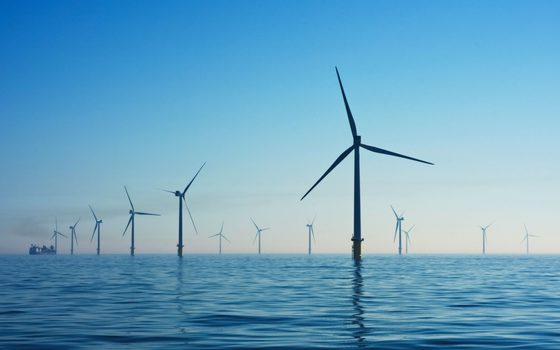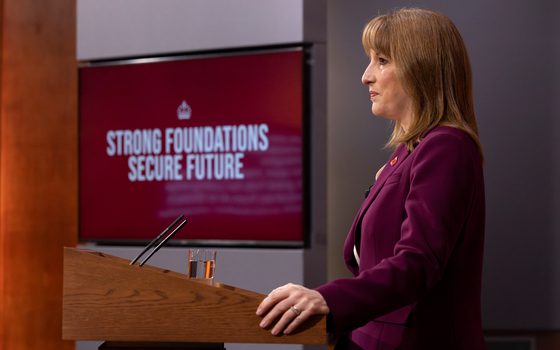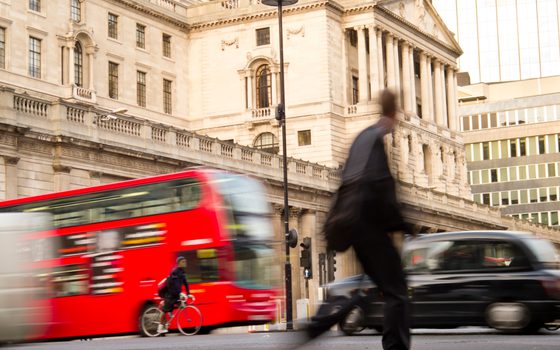It’s time for interest rates to go green
The UK’s overdependence on fossil fuels makes us vulnerable to price shocks, we need the Bank of England and the government to be encouraging green investment
01 November 2023
Higher interest rates have hit businesses’ ability and desire to invest in the cheap renewable energy the UK needs to bring down bills and overcome the cost of living crisis. We saw this in action in a recent failed offshore wind auction, when no company bid to build the offshore wind farms we desperately need. There is a policy solution that would encourage investment in renewables, fossil-free transport and insulation to keep our homes warm with less energy: the Bank of England could introduce lower interest rates for green projects. . Our new analysis shows that reducing interest rates for energy transition investments could save £6.2bn for UK businesses and households over 2024 – 27.
The UK was hit particularly hard by inflation following Russia’s invasion of Ukraine due to our over-reliance on fossil fuels. When gas prices spiked, this led to huge increases in energy costs, which then pushed up other prices as businesses faced higher costs. Similarly, the war and recent climate disasters have disrupted food supplies leading to rapid increases in food prices.
The traditional response to inflation — higher interest rates – is inappropriate in this context. Raising interest rates only reduces inflation when it is caused by excess demand. By making borrowing more expensive and saving more attractive, rate hikes are meant to make families and firms spend less and save more. The resulting reduction in demand then discourages workers from bargaining for ever-higher wages.
However, rate hikes do not address the underlying causes of today’s high inflation: the UK’s underinvestment in home-grown clean energy and home retrofitting, which are the factors that led to our reliance on natural gas. Worse, by increasing the costs of borrowing, higher interest rates make the investments we need to prevent future ‘fossilflation’ shocks more costly and so less likely to happen.
It is here that Bank policy should adjust to allow for the green investments we need. As things stand, the Bank Rate is a blunt tool, leading to changing costs of credit across the board (see Figure 1) without distinguishing between essential investments and less desirable activities.
Figure 1: Changes in the Bank Rate influence lending rates to firms and individuals, albeit to differing extents
Costs of capital (the money owed back to the banks and investors who fund projects) are a potentially large share of the total costs of net zero. The Climate Change Committee’s Finance Advisory Group reported that, in an uncertain policy environment, costs of capital could represent over 30% of overall net zero investment. Strong policy signals have the power to reduce this significantly, making green investment a cheaper and more attractive proposition for businesses.
High financing costs harm the business case for renewable energy projects, and lead to the risk that projects won’t go ahead. Renewables projects require high upfront capital investment, but they then generate significant savings once in operation (because they free us from purchasing expensive fossil fuels on global markets).
Renewable energy projects are particularly sensitive to changes in the cost of capital, of which the cost of debt (loans) is generally the largest component. For some projects, high interest payments mean that total costs now outweigh the expected income from selling electricity. A recent study by Dutch consulting firm Berenschot found that further rate rises would cause the average wind project in the Netherlands to become a loss-making investment. High inflation affecting key inputs such as steel and other core materials has also exacerbated the cost pressures faced by renewable projects.
Even though clean energy remains cheaper than gas, in the absence of policy intervention investors will simply cancel or delay clean energy investments due to higher financing costs. This will mean we stay reliant on expensive fossil fuels for longer and contribute to further climate chaos.
But there is an obvious alternative. The Bank of England could implement a Green Term Funding Scheme, where the Bank would finance green investments at a lower interest rate. This would mean the financing costs of renewables projects falling substantially and companies would be able to afford to invest in new projects (without needing subsidies from the government).
In the period 2024 – 27, the UK will need to invest on average £54bn per year to bring down energy costs and reduce emissions. This is based on the CCC’s balanced investment pathway (we have converted all figures into nominal terms using inflation forecasts from NIESR). Drawing on analysis by the Office for Budget Responsibility and the International Energy Agency, we estimate that £27bn per year of this investment will need to be funded by private loans.
If all essential investments go ahead, we estimate that the payments on this debt over the next four years would amount to £13.7bn under currently forecast interest rates. However, in an alternative scenario where a ‘dual rates policy’ reduces green interest rates to 2019 levels, private interest costs would be reduced to £7.4bn, with a saving of £6.2bn (rounded to the nearest £0.1bn). This amounts to a 46% reduction in private finance costs, and a 6% reduction in the total cost of private net zero investment over the period. This does not include any potential effect on the cost of equity (the percentage return demanded by shareholders in return for their investment), which is related to the central bank interest rate, but much less directly than the cost of debt.
Figure 2: Financing net zero transition will cost significantly more over the next four years at projected interest rates compared to under a dual rates approach
The significant cost savings illustrated by our analysis further strengthen the case for a ‘dual interest rates’ approach, where a central bank offers private banks a cheaper refinancing rate for green projects. This approach has previously been advocated by the Monetary Policy Committee member Megan Greene. Our analysis in this blog illustrates the potential savings on financing costs that could be generated by a scheme which brings financing conditions for green projects back down to pre-Covid low interest rates.
To implement this, the Bank should update its Term Funding Scheme (TFS) with a green variant to give a preferential low interest rate for specified green investments. The scheme has already set a precedent for this: the original 2016 TFS offered lower interest rates to banks who lent more to UK real economy (i.e. non-financial) businesses, and a new version was launched in 2020 with additional incentives for banks to lend to small and medium businesses. The government and the Bank should jointly establish the criteria for the new green TFS. In its most targeted form, it should support renewable energy and retrofitting projects, but a greater range of net zero investments could be included alongside the right mechanisms to prevent greenwashing. This would require the appropriate verification and tracking of the flow of money in and out of companies, for example through embedding the upcoming UK Green Taxonomy.
The Bank could then specify operational parameters, which should aim to bring financing conditions for green investments back to their 2019 levels. For maximum effect, this could be combined with government-led measures, such as partial loan guarantees to reduce risk premiums, as part of broader green credit guidance.
By enabling a rapid transition away from expensive and volatile fossil fuels, a well-targeted green TFS would be counter-inflationary in the medium to long term. Thus such a scheme would support the Bank in delivering both its primary mandate of price stability and its secondary mandate of supporting government economic policy, including the net zero transition. It would do so by speeding up our transition away from fossil fuels through reducing the financing costs of renewable energy projects. This means cheaper renewable electricity and less vulnerability to future energy price shocks.
Critics might argue that a green TFS would be inflationary by increasing short-term demand for goods and services. However, a well-targeted scheme could primarily be aimed at protecting the necessary level of green investment rather than promoting additional expansion in the short term, thus reducing the risks of inflation affecting green goods and services.
Combined with greater monetary-fiscal coordination on combating inflation – alongside the higher main interest rate – such a scheme would help resolve the trade-offs between restrictive near-term policy and the need to safeguard progress in mitigating climate and fossil fuels related instability risks. By supporting the green transition policymakers can achieve a ‘divine coincidence’, delivering both lower inflation and decarbonisation of the economy.
For maximum impact, the government should further leverage the UK Infrastructure Bank and the British Business Bank to increase the amount of low-cost financing for projects in the long-term national interest. This is especially important given that, since Brexit, UK banks have failed by a wide margin to replace the funding provided earlier by the European Investment Bank (EIB), investing only a third as much in 2022 compared to the EIB in 2016. Lastly, a publicly-owned energy generator could improve the functioning of the energy market, remove our reliance on short-term profitability, and help lower bills.
The current cost of living crisis was predominantly caused by a surge in global gas prices. Now, we need to use every policy tool at our disposal to invest in cheap green energy and reduce our reliance on fossil fuels. The objectives of the government and the Bank of England are aligned; ending the cost of living crisis and protecting price stability are two sides of the same coin. Since a fast green transition is the best way to protect price and financial stability, it is prudent for policymakers to act quickly. That is why the Treasury should work with the Bank of England to introduce a green TFS that will lead to more green investments, and lower prices, as a matter of urgency.
Methodology for forecasting interest rates
We compare average interest rates on business and household loans (excl. mortgages) in the pre-pandemic conditions of 2019, when the Bank Rate was set at a very low level of 0.75%, up to the most recent effective interest rates, as the Bank Rate has been increased to 5.25%. Changes in the Bank Rate are not the sole determinant of changes in commercial lending rates, which can be influenced by other events – such as the temporary spike in bond yields and mortgage rates following the Liz Truss ‘mini-budget’. Rates on longer-term loans also incorporate expectations about future interest rates and future inflation. Specific lending rates will also vary from project to project. But as the International Renewable Energy Agency observes, the ‘lagged impact of rising interest rates on LCOEs [levelised cost of electricity] will be significant’ over the coming years in comparison to the low cost of capital for renewables that prevailed up to 2021.
Given the various influencing factors, the transmission from the Bank Rate to bank lending rates is not one-for-one (i.e. five percentage points increase in the former does not transmit to precisely five percentage increase in the latter). However, while the effect on specific loans and bond yields varies, there’s still a clear relationship between the Bank Rate and interest rates charged by banks (see Figure 1 above). This differs again by the type of the loan. For example, mortgages and loans to businesses react strongly, while unsecured loans to households are somewhat less sensitive. Incorporating differential impacts by the type of lending (as above) we can draw a connection between the level of the Bank Rate and financing conditions faced by firms and households. We use these estimated impacts to forecast changes in the cost of debt for green investments faced respectively by firms and households.
To approximate the relationship in recent data (since 2019), we estimate a simple regression based on observed relationships between the bank rate and effective interest rates by lending type. While monetary policy impacts the broader economy with the proverbial ‘long and variable’ lags, the transmission of policy rate to interest rates on new loans tends to happen quickly as interest rates rise (which is the current context), particularly for lending to firms. In line with this, we include a one-quarter lag for the transmission of the Bank Rate to interest rates on new loans. We use the calculated effects to estimate interest costs under the annual average Bank Rate forecast by NIESR over 2024 – 27. We compare this to a hypothetical future where interest rates for green investments are equal to the average effective interest rates in 2019, before the Covid-19 pandemic and when the Bank Rate was (and had been for several years) 0.75%. This alternative scenario illustrates accommodative financing conditions, without the impact of the shocks and monetary tightening that have since caused rates to rise. It is the basis of our estimate that private net zero finance costs would be reduced by £6.2bn under a green TFS calibrated to restore 2019-level financing conditions for green loans.
To estimate annual and cumulative impacts we also incorporate assumptions about debt maturity and repayment. Larger projects such as offshore wind farms are typically financed with loans of 15 – 20 year duration, while smaller green loans may have significantly shorter maturity. In our modelling we follow the CCC Advisory Group on Finance in assuming a 7.5‑year repayment period for loans, with equal annual repayments of principal and interest calculated accordingly. We assume that the investments on the CCC’s pathway in a given calendar year are spaced evenly throughout that year.
To arrive at our figure for the proportion of investment funded by private debt, we first estimate that around 75% of Net Zero investments on the CCC’s balanced pathway must be financed by the private sector and individuals, as per the OBR 2021 Fiscal Risk Report central scenario. Then – drawing on sectoral analysis from the International Energy Agency to determine debt/equity ratios by sector – we estimate that 68% of overall private investment will be financed by debt, with the rest funded by equity or savings. All analysis is carried out on a year-by-year, sector-by-sector approach, following the CCC’s pathway.
Image: iStock
Topics Banking & finance Climate change






